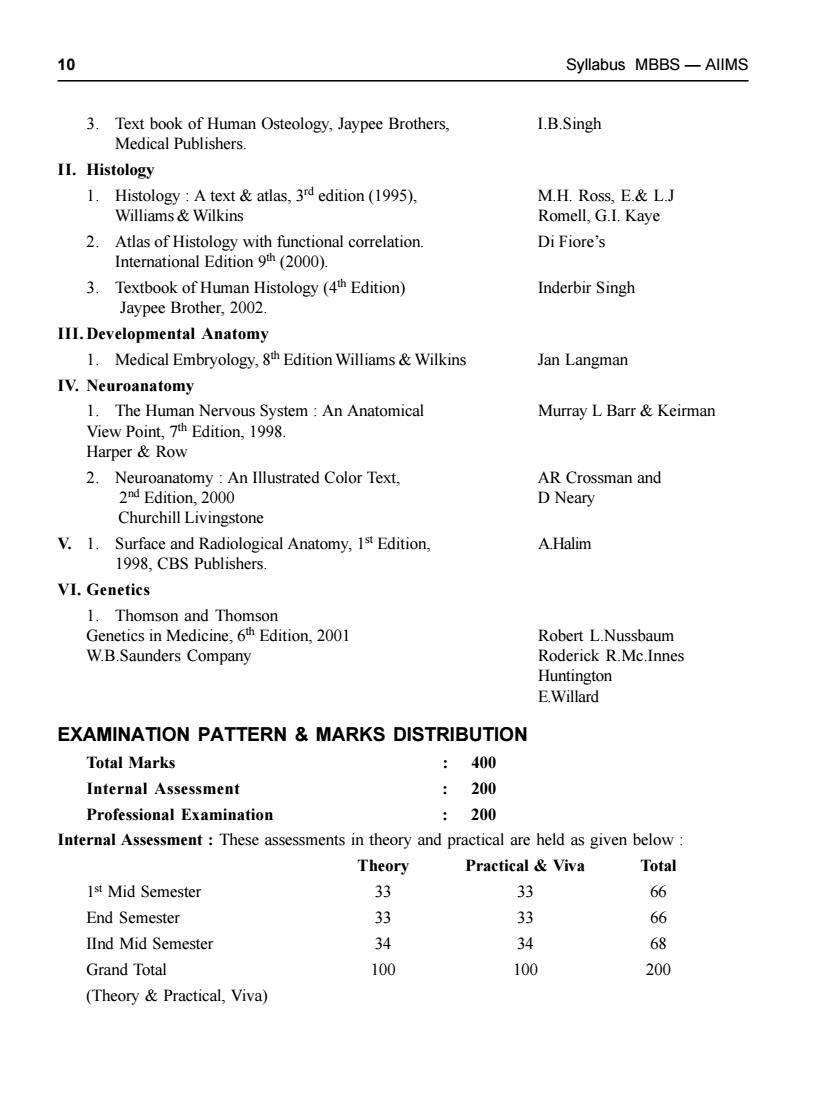
10Syllabus MBBS—AIIMSI.B.Singh3.TextbookofHumanOsteology,JaypeeBrothers,Medical Publishers.II. HistologyHistology : A text & atlas, 3rd edition (1995)M.H.Ross, E.& L.J1.Williams&WilkinsRomell, G.I. KayeDiFiore's2.Atlas of Histology withfunctional correlationInternational Edition9th (2000)3.TextbookofHumanHistology (4thEdition)Inderbir SinghJaypeeBrother,2002Ill.DevelopmentalAnatomyJan Langman1.MedicalEmbryology,gthEditionWilliams&WilkinsIV.Neuroanatomy1.TheHumanNervous System:An AnatomicalMurrayLBarr&KeirmanView Point, 7th Edition, 1998.Harper&RowAR Crossman and2.Neuroanatomy:An IllustratedColorText,2nd Edition,2000DNearyChurchill LivingstoneV.1.A.HalimSurface and Radiological Anatomy,1stEdition,1998, CBS Publishers.VI.Genetics1.Thomsonand ThomsonGenetics inMedicine,6th Edition,2001Robert L.NussbaumW.B.SaundersCompanyRoderickR.Mc.InnesHuntingtonE.WillardEXAMINATIONPATTERN&MARKSDISTRIBUTION400Total Marks:200InternalAssessment:200ProfessionalExamination:Internal Assessment : These assessments in theory and practical are held as given below:TheoryPractical & VivaTotal333366Ist Mid Semester333366End Semester343468IInd Mid Semester100100200Grand Total(Theory & Practical, Viva)
10 Syllabus MBBS — AIIMS 3. Text book of Human Osteology, Jaypee Brothers, I.B.Singh Medical Publishers. II. Histology 1. Histology : A text & atlas, 3rd edition (1995), M.H. Ross, E.& L.J Williams & Wilkins Romell, G.I. Kaye 2. Atlas of Histology with functional correlation. Di Fiore’s International Edition 9th (2000). 3. Textbook of Human Histology (4th Edition) Inderbir Singh Jaypee Brother, 2002. III. Developmental Anatomy 1. Medical Embryology, 8th Edition Williams & Wilkins Jan Langman IV. Neuroanatomy 1. The Human Nervous System : An Anatomical Murray L Barr & Keirman View Point, 7th Edition, 1998. Harper & Row 2. Neuroanatomy : An Illustrated Color Text, AR Crossman and 2nd Edition, 2000 D Neary Churchill Livingstone V. 1. Surface and Radiological Anatomy, 1st Edition, A.Halim 1998, CBS Publishers. VI. Genetics 1. Thomson and Thomson Genetics in Medicine, 6th Edition, 2001 Robert L.Nussbaum W.B.Saunders Company Roderick R.Mc.Innes Huntington E.Willard EXAMINATION PATTERN & MARKS DISTRIBUTION Total Marks : 400 Internal Assessment : 200 Professional Examination : 200 Internal Assessment : These assessments in theory and practical are held as given below : Theory Practical & Viva Total 1st Mid Semester 33 33 66 End Semester 33 33 66 IInd Mid Semester 34 34 68 Grand Total 100 100 200 (Theory & Practical, Viva)
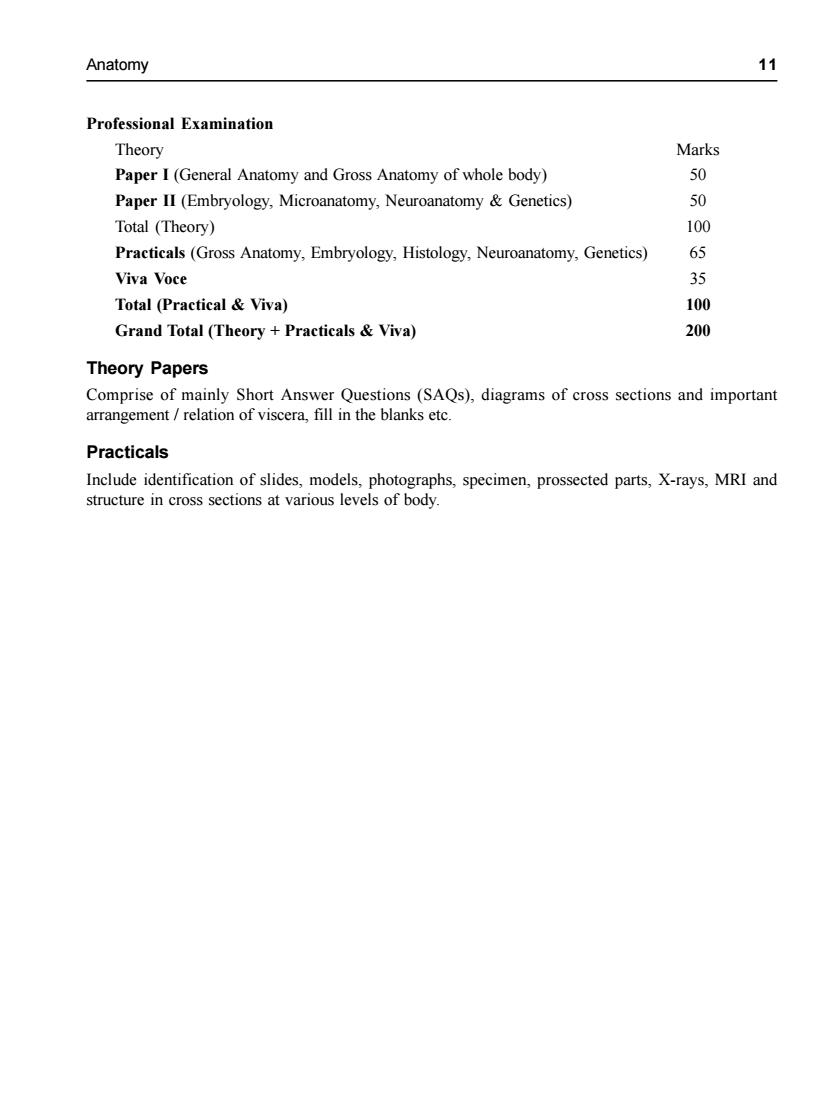
11AnatomyProfessional ExaminationMarksTheory50PaperI(GeneralAnatomyandGrossAnatomyofwholebody)50PaperII(Embryology,Microanatomy,Neuroanatomy&Genetics)100Total (Theory)65Practicals(GrossAnatomy,Embryology,Histology,Neuroanatomy,Genetics)35Viva Voce100Total (Practical&Viva)200Grand Total (Theory +Practicals & Viva)TheoryPapersComprise ofmainly ShortAnswerQuestions(SAQs),diagramsof cross sectionsand importantarrangement/relationofviscera,fill intheblanksetcPracticalsIncludeidentification of slides,models,photographs, specimen,prossected parts,X-rays, MRI andstructure in crosssections atvarious levels of body
Anatomy 11 Professional Examination Theory Marks Paper I (General Anatomy and Gross Anatomy of whole body) 50 Paper II (Embryology, Microanatomy, Neuroanatomy & Genetics) 50 Total (Theory) 100 Practicals (Gross Anatomy, Embryology, Histology, Neuroanatomy, Genetics) 65 Viva Voce 35 Total (Practical & Viva) 100 Grand Total (Theory + Practicals & Viva) 200 Theory Papers Comprise of mainly Short Answer Questions (SAQs), diagrams of cross sections and important arrangement / relation of viscera, fill in the blanks etc. Practicals Include identification of slides, models, photographs, specimen, prossected parts, X-rays, MRI and structure in cross sections at various levels of body
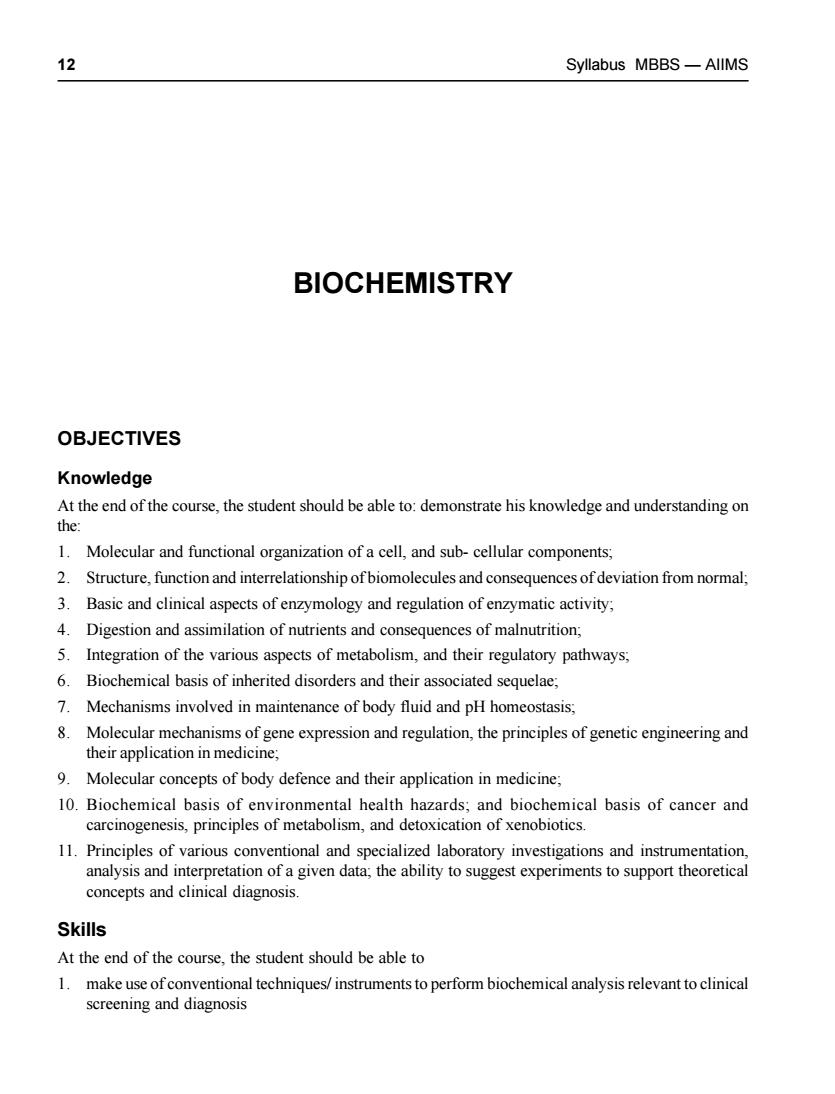
12Syllabus MBBS—AIIMSBIOCHEMISTRYOBJECTIVESKnowledgeAt the end of the course, the student should be able to: demonstrate his knowledge and understanding onthe:1.Molecularandfunctional organization of a cell,and sub-cellular components,2.Structure,function and interrelationship ofbiomolecules and consequences of deviation from normal;3.Basic and clinical aspects of enzymology and regulation of enzymatic activity,4.Digestion and assimilation of nutrients and consequences of malnutrition;5.Integrationof thevarious aspects of metabolism,andtheir regulatory pathways;6.Biochemical basis of inherited disorders and their associated sequelae,7.Mechanisms involved in maintenance of body fluid and pHhomeostasis;8.Molecular mechanisms of gene expression and regulation, the principles of genetic engineering andtheir application in medicine9.Molecular concepts of body defence and their application in medicine;10.Biochemical basis of environmental healthhazards;and biochemical basis of cancerandcarcinogenesis,principlesofmetabolism,anddetoxicationofxenobiotics.1l.Principles of various conventional and specialized laboratory investigations and instrumentation,analysis and interpretation ofa given data, the ability to suggest experiments to support theoreticalconcepts and clinical diagnosis.SkillsAttheendof thecourse,thestudent shouldbeableto1.makeuseofconventional techniques/instruments to performbiochemical analysis relevanttoclinicalscreening and diagnosis
12 Syllabus MBBS — AIIMS BIOCHEMISTRY OBJECTIVES Knowledge At the end of the course, the student should be able to: demonstrate his knowledge and understanding on the: 1. Molecular and functional organization of a cell, and sub- cellular components; 2. Structure, function and interrelationship of biomolecules and consequences of deviation from normal; 3. Basic and clinical aspects of enzymology and regulation of enzymatic activity; 4. Digestion and assimilation of nutrients and consequences of malnutrition; 5. Integration of the various aspects of metabolism, and their regulatory pathways; 6. Biochemical basis of inherited disorders and their associated sequelae; 7. Mechanisms involved in maintenance of body fluid and pH homeostasis; 8. Molecular mechanisms of gene expression and regulation, the principles of genetic engineering and their application in medicine; 9. Molecular concepts of body defence and their application in medicine; 10. Biochemical basis of environmental health hazards; and biochemical basis of cancer and carcinogenesis, principles of metabolism, and detoxication of xenobiotics. 11. Principles of various conventional and specialized laboratory investigations and instrumentation, analysis and interpretation of a given data; the ability to suggest experiments to support theoretical concepts and clinical diagnosis. Skills At the end of the course, the student should be able to 1. make use of conventional techniques/ instruments to perform biochemical analysis relevant to clinical screening and diagnosis
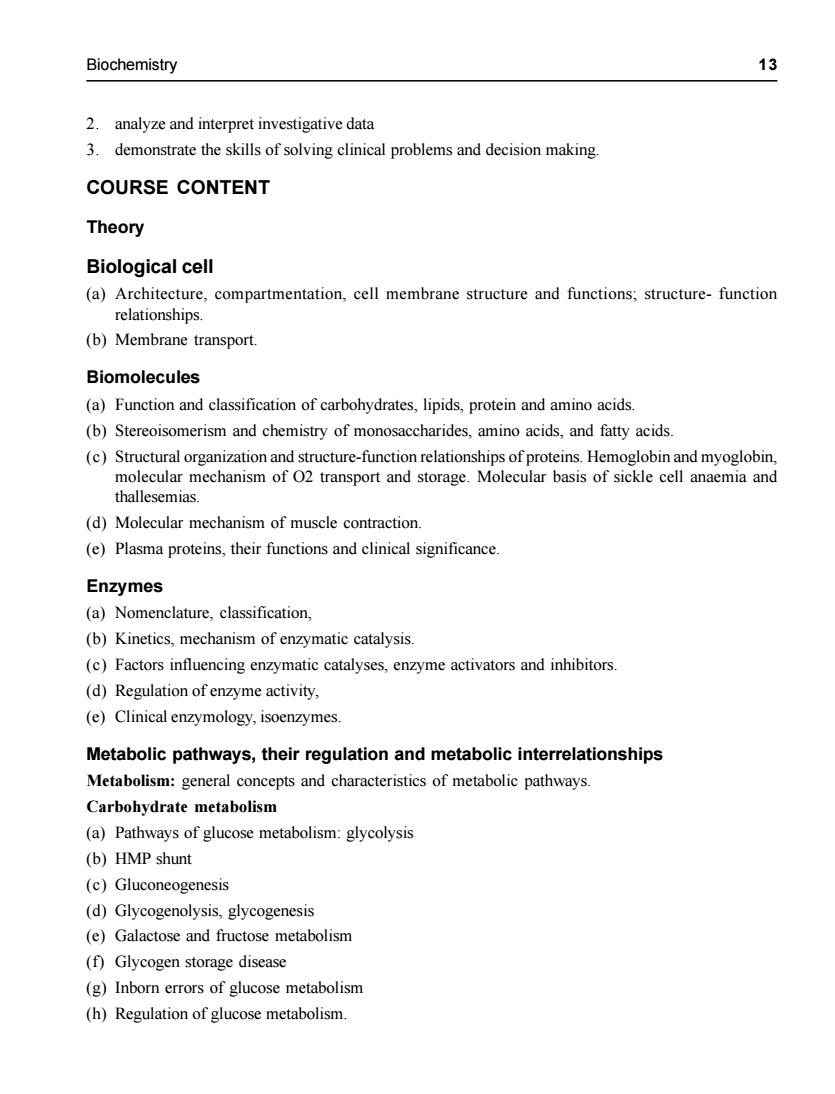
13Biochemistry2.analyze and interpret investigative data3.demonstrate the skills of solving clinical problems and decision makingCOURSECONTENTTheoryBiological cell(a) Architecture, compartmentation, cell membrane structure and functions;, structure-functionrelationships.(b)MembranetransportBiomolecules(a)Function and classification of carbohydrates,lipids,protein and amino acids.(b)Stereoisomerism and chemistry ofmonosaccharides, amino acids,and fatty acids(c)Structural organization and structure-function relationships of proteins.Hemoglobin and myoglobinmolecularmechanismof O2transportand storage.Molecularbasis of sicklecell anaemiaandthallesemias.(d)Molecularmechanismofmusclecontraction(e)Plasmaproteins,theirfunctions and clinical significance.Enzymes(a)Nomenclature, classification,(b)Kinetics,mechanismofenzymaticcatalysis.(c)Factors influencing enzymaticcatalyses,enzymeactivators and inhibitors.(d)Regulation of enzyme activity,(e) Clinical enzymology, isoenzymes.Metabolicpathways,theirregulationandmetabolicinterrelationshipsMetabolism:general conceptsand characteristics ofmetabolic pathwaysCarbohydrate metabolism(a) Pathways of glucose metabolism: glycolysis(b) HMP shunt(c)Gluconeogenesis(d) Glycogenolysis, glycogenesis(e)Galactoseandfructosemetabolism(f)Glycogen storage disease(g)Inborn errors of glucosemetabolism(h)Regulationofglucosemetabolism
Biochemistry 13 2. analyze and interpret investigative data 3. demonstrate the skills of solving clinical problems and decision making. COURSE CONTENT Theory Biological cell (a) Architecture, compartmentation, cell membrane structure and functions; structure- function relationships. (b) Membrane transport. Biomolecules (a) Function and classification of carbohydrates, lipids, protein and amino acids. (b) Stereoisomerism and chemistry of monosaccharides, amino acids, and fatty acids. (c) Structural organization and structure-function relationships of proteins. Hemoglobin and myoglobin, molecular mechanism of O2 transport and storage. Molecular basis of sickle cell anaemia and thallesemias. (d) Molecular mechanism of muscle contraction. (e) Plasma proteins, their functions and clinical significance. Enzymes (a) Nomenclature, classification, (b) Kinetics, mechanism of enzymatic catalysis. (c) Factors influencing enzymatic catalyses, enzyme activators and inhibitors. (d) Regulation of enzyme activity, (e) Clinical enzymology, isoenzymes. Metabolic pathways, their regulation and metabolic interrelationships Metabolism: general concepts and characteristics of metabolic pathways. Carbohydrate metabolism (a) Pathways of glucose metabolism: glycolysis (b) HMP shunt (c) Gluconeogenesis (d) Glycogenolysis, glycogenesis (e) Galactose and fructose metabolism (f) Glycogen storage disease (g) Inborn errors of glucose metabolism (h) Regulation of glucose metabolism
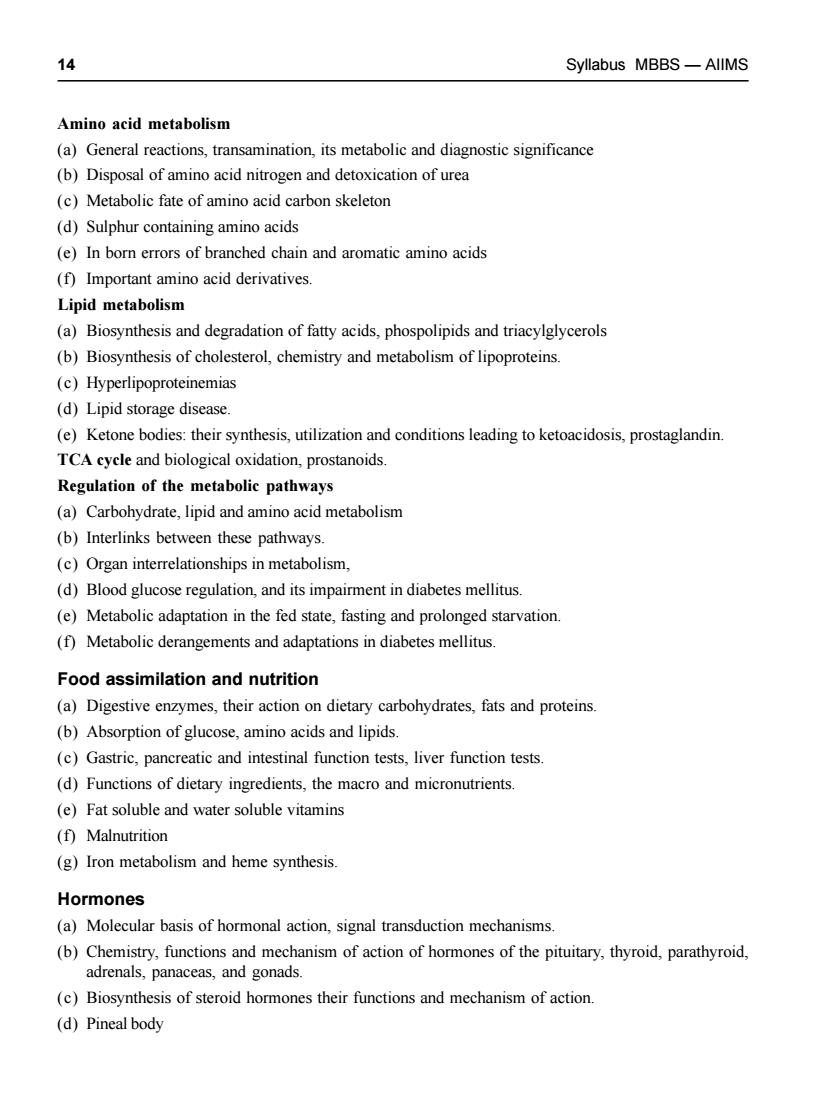
14Syllabus MBBS—AIIMSAmino acid metabolism(a)General reactions, transamination, its metabolic and diagnostic significance(b)Disposal ofaminoacidnitrogenand detoxication ofurea(c)Metabolicfateof aminoacid carbonskeleton(d)Sulphurcontaining aminoacids(e)Inborn errors of branched chain andaromaticaminoacids(f)Important amino acid derivatives.Lipid metabolism(a) Biosynthesis and degradation of fatty acids, phospolipids and triacylglycerols(b)Biosynthesis of cholesterol, chemistry and metabolism of lipoproteins(c)Hyperlipoproteinemias(d)Lipid storagedisease(e)Ketone bodies: their synthesis, utilization and conditions leading to ketoacidosis, prostaglandinTCAcycleand biological oxidation,prostanoids.Regulation of the metabolic pathways(a)Carbohydrate,lipid and aminoacidmetabolism(b)Interlinks between these pathways.(c) Organ interrelationships in metabolism,(d)Blood glucose regulation,and its impairment in diabetes mellitus(e)Metabolic adaptation in thefed state,fastingandprolonged starvation(f)Metabolic derangements and adaptations in diabetes mellitus.Food assimilationand nutrition(a)Digestive enzymes, theiraction on dietary carbohydrates,fats and proteins(b)Absorptionof glucose,amino acids and lipids(c) Gastric, pancreatic and intestinal function tests, liver function tests(d)Functions of dietary ingredients, the macro and micronutrients.(e) Fat soluble and water soluble vitamins(f)Malnutrition(g) Iron metabolism and heme synthesis.Hormones(a)Molecular basis of hormonal action, signal transduction mechanisms.(b)Chemistry,functions and mechanism of action of hormones of the pituitary,thyroid, parathyroid,adrenals, panaceas, and gonads.(c)Biosynthesis of steroidhormonestheirfunctionsandmechanismof action.(d)Pineal body
14 Syllabus MBBS — AIIMS Amino acid metabolism (a) General reactions, transamination, its metabolic and diagnostic significance (b) Disposal of amino acid nitrogen and detoxication of urea (c) Metabolic fate of amino acid carbon skeleton (d) Sulphur containing amino acids (e) In born errors of branched chain and aromatic amino acids (f) Important amino acid derivatives. Lipid metabolism (a) Biosynthesis and degradation of fatty acids, phospolipids and triacylglycerols (b) Biosynthesis of cholesterol, chemistry and metabolism of lipoproteins. (c) Hyperlipoproteinemias (d) Lipid storage disease. (e) Ketone bodies: their synthesis, utilization and conditions leading to ketoacidosis, prostaglandin. TCA cycle and biological oxidation, prostanoids. Regulation of the metabolic pathways (a) Carbohydrate, lipid and amino acid metabolism (b) Interlinks between these pathways. (c) Organ interrelationships in metabolism, (d) Blood glucose regulation, and its impairment in diabetes mellitus. (e) Metabolic adaptation in the fed state, fasting and prolonged starvation. (f) Metabolic derangements and adaptations in diabetes mellitus. Food assimilation and nutrition (a) Digestive enzymes, their action on dietary carbohydrates, fats and proteins. (b) Absorption of glucose, amino acids and lipids. (c) Gastric, pancreatic and intestinal function tests, liver function tests. (d) Functions of dietary ingredients, the macro and micronutrients. (e) Fat soluble and water soluble vitamins (f) Malnutrition (g) Iron metabolism and heme synthesis. Hormones (a) Molecular basis of hormonal action, signal transduction mechanisms. (b) Chemistry, functions and mechanism of action of hormones of the pituitary, thyroid, parathyroid, adrenals, panaceas, and gonads. (c) Biosynthesis of steroid hormones their functions and mechanism of action. (d) Pineal body